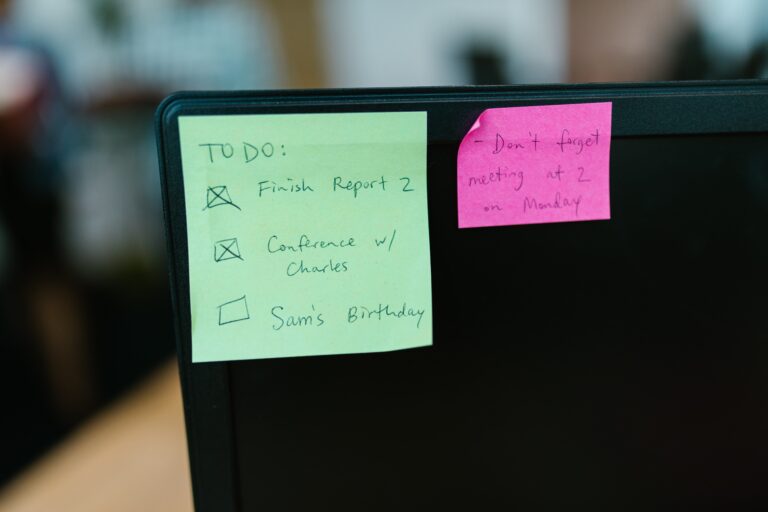Get More Done in Less time by Reducing Distractions
October 28th 2022
The opportunities for distraction today are greater than they’ve ever been. With phones by our side 24/7, social media calling our name, and anxiety seemingly ever-present, it’s challenging for anyone to stay focused on any one task for more than a few minutes.
And yet, staying on-task is critical for progress to be made. Spread your efforts and attention over multiple tasks at one time and you’ll make little progress on anything, or the progress you do make won’t be your best work.
So, what’s the secret?
There’s really no secret or trick, but getting more done requires getting organized and setting yourself up to stay on task.
Start with a to-do list
Getting more done starts with identifying what your highest priority tasks are. What’s on your to-do list?
It can help to make a master list of absolutely everything you can think of that you need to do, from drafting a blog post to responding to a customer’s email to picking up dry cleaning, placing your meal subscription order for next week, and paying your utility bill. Get everything out of your head and onto a sheet of paper or into a Google doc where you can see it.
Distinguish between important and urgent
Next, go through your list and identify the top things you must get done today. Rank them from 1 to 10. Although it’s best not to try to do more than three major things in a day, if some of your action items are sending emails or making phone calls, you can get more than three accomplished.
As part of your ranking process, think about which activities will have the greatest impact on your business success. Which proposal has the potential to bring in the most money? Which tactful email needs to be sent to calm an irritated client? Which Yelp review needs a response? Which supplier needs a call to clear up confusion about your order?
Some tasks may have deadlines that are in the next day or two and that could eat up most of your day, but are they really essential? Just because someone else has assigned a deadline doesn’t automatically make it important to you. (Sure, your sister wants a call back to catch up this afternoon, but is that the best use of your time today? If not, call her tonight or tomorrow.)
Then there are tasks that have deadlines that have the potential to make or break your business, like the deadline to be considered for a grant, or to be quoted in an article, or join a business accelerator.
Which to-dos are most important? Those go to the top of your list.
Break down larger tasks
Now that you have a list of your highest priority tasks, start with your top priority. Think through what it will take to complete this activity and break it down into 10-15-minute tasks. You may have been putting it off because it seemed so overwhelming, such as responding to an RFP or outlining a course you want to release. So, break it down into smaller pieces, and then break those down, and again, until each task is super quick and easy.
Finally, get that very first piece related to your top priority done. Then, move on to the next piece of that first priority, and to the next, and keep crossing those steps off your to-do list as you complete them. Only stop when you can’t do any more, either because you have an appointment to get to or because you need information from other people before you can do more.
At that point, it’s time for a break. Take a few minutes to relax, maybe take a short walk, get some lunch, for example.
After your break, come back and go through that same process for your second-highest priority.
Avoid multitasking
You’ve probably heard how inefficient multitasking, or task switching, is. Sure, it may feel like being on the phone while you also read or respond to emails is killing two birds with one stone, but it’s not. You’re not giving all of your attention to the person on the other end of the phone, which makes it less effective, and you may be missing key pieces of information in those emails you’re skimming.
Research has shown that you are up to 40 percent less productive when you multitask. Also, the results of your efforts are of lower quality. A London study found that “multitasking dropped a person’s IQ at the same pace that someone experiences after a sleepless night.” Meaning, you aren’t able to do your best work.
Instead, do one task at a time. Focusing on one action item allows you to devote all of your attention to it, which will actually help you complete it faster.
Optimize your environment
Sometimes where you work impacts your ability to focus, so take steps to improve your surroundings.
Cleaning your desk and work area off helps reduce distractions, because your eye is able to focus on what’s in front of you, and not what’s in the piles off to the side. Closing your email while you work also prevents new messages from pinging and alerting you, which can cause you to fear you’re missing something important. And if you work in a noisy setting, consider getting noise-blocking headphones to drown out the chatter or ambient sounds that can interfere with mental function.
If you know you need support to prevent you from taking a peek at social media, consider getting a program like Freedom, which blocks your access to certain websites for whatever period of time you specify. Want to force yourself to work uninterrupted for 30 minutes? Use Freedom to keep you from checking the latest Facebook or Instagram posts.
Once you’re clear on what you absolutely have to get done, by when, and you take steps to reduce potential distractions around you, you’ll get much more done faster.



















